Lightning Surge Analysis on a Large Scale Grid-Connected Solar Photovoltaic System
Abstract
:1. Introduction
2. Background of Solar PV System in Malaysia
3. Lightning Overview and Differences in Modelling Lightning Current Waveshape
4. Lightning Standard and Nonstandard Current Waveshapes with Different Amplitudes
5. Lightning Effect on Solar PV Farm and Applicable Standards
6. Modelling of a Grid-Connected Solar PV Farm System (Case Studies)
7. Result and Discussion
8. Conclusions
Acknowledgments
Author Contributions
Conflicts of Interest
References
- Mun, W.K.; Razali, H.M.; Almsafir, M.K.; Hamid, F.A. Prospects of Solar Energy for Domestic Area in Malaysia. In Proceedings of the 3rd National Graduate Conference (NatGrad2015), Kajang, Malaysia, 8–9 April 2015; pp. 332–337. [Google Scholar]
- Hussin, M.; Yaacob, A.; Zain, Z.; Shaari, S.; Omar, A. Status of a Grid-connected MBIPV Project in Malaysia. In Proceedings of the 3rd International Symposium & Exhibition in Sustainable Energy & Environment, Melaka, Malaysia, 1–3 June 2011; pp. 4–11. [Google Scholar]
- Hussin, M.; Yaacob, A.; Rahman, R.; Zain, Z.; Shaari, S.; Omar, A. Monitoring results of Malaysian building integrated PV Project in Grid-connected photovoltaic system in Malaysia. Energy Power 2012, 2, 39–45. [Google Scholar] [CrossRef]
- National Lightning Safety Institute. Available online: www.lightningsafety.com/nlsi_info/world-lightning-activity.html (accessed on 15 October 2017).
- Chowdhury, S.R.; Saha, H. Maximum power point tracking of partially shaded solar photovoltaic arrays. Sol. Energy Mater. Sol. Cells 2010, 94, 1441–1447. [Google Scholar] [CrossRef]
- DEHN. Lightning and Surge Protection for Free Field PV Power Plants; DEHN: Neumarkt, Germany, 2014; p. 15. [Google Scholar]
- Chowdhuri, P. Parameters of lightning strokes and their effects on power systems. In Proceedings of the 2001 IEEE/PES Transmission and Distribution Conference and Exposition, Atlanta, GA, USA, 2 November 2001; pp. 1047–1051. [Google Scholar]
- Treble, F. Milestones in the development of crystalline silicon solar cells. Renew. Energy 1998, 15, 473–478. [Google Scholar] [CrossRef]
- Jol, J.; Mandoc, M.; Molenbroek, E. Solar Electricity 2008—A Technical and Economic Overview; Ecofys BV: Kanaalweg, The Netherlands, 2008. [Google Scholar]
- Van Sark, W.; Korte, L.; Roca, F. Physics and Technology of Amorphous-Crystalline Heterostructure Silicon Solar Cells; Springer: New York, NY, USA, 2012. [Google Scholar]
- Dobrzański, L.; Drygała, A.; Giedroć, M.; Macek, M. Monocrystalline silicon solar cells applied in photovoltaic system. J. Achiev. Mater. Manuf. Eng. 2012, 53, 7–13. [Google Scholar]
- Jäger, K.; Isabella, O.; Smets, A.H.; Van Swaaij, R.A.C.M.M.; Zeman, M. Solar Energy-Fundamentals, Technology, and Systems; Delft University of Technology: Delft, The Netherlands, 2014. [Google Scholar]
- Glunz, S.; Preu, R.; Biro, D. Chapter 1.16: Crystalline Silicon Solar Cells—State-of-the-Art and Future Developments. In Comprehensive Renewable Energy; Elsevier: Amsterdam, The Netherlands, 2012; pp. 353–387. [Google Scholar]
- Hussin, M.; Hasliza, N.; Yaacob, A.; Zain, Z.; Omar, A.; Shaari, S. A development and challenges of grid-connected photovoltaic system in Malaysia. In Proceedings of the Control and System Graduate Research Colloquium (ICSGRC), Shah Alam, Malaysia, 16–17 July 2012. [Google Scholar]
- Ghazali, A.M.; Rahman, A.M.A. The performance of three different solar panels for solar electricity applying solar tracking device under the Malaysian climate condition. Energy Environ. Res. 2012, 2, 235. [Google Scholar] [CrossRef]
- Installation of Grid-Connected Photovoltaic (PV) System; MS 1837; Department of Standards Malaysia: Cyberjaya, Malaysia, 2010.
- Rakov, V.A. Fundamentals of Lightning. In Proceedings of the International Symposium on Lightning Protection, Kathmandu, Nepal, 12–14 October 2011. [Google Scholar]
- Lightning and Insulator Subcommittee of T&D Committee. Parameters of lightning strokes: A review. IEEE Trans. Power Deliv. 2005, 20, 346–358. [Google Scholar]
- Wang, J.; Zhang, X. Double-exponential expression of lightning current waveforms. In Proceedings of the 2006 4th Asia-Pacific Conference on Environmental Electromagnetics, Dalian, China, 1–4 August 2006. [Google Scholar]
- Heidler, F.; Cvetic, J.; Stanic, B. Calculation of lightning current parameters. IEEE Trans. Power Deliv. 1999, 14, 399–404. [Google Scholar] [CrossRef]
- Electromagnetic Compatibility (EMC)—Part 4-5: Testing and Measurement Techniques–Surge Immunity Test; MS IEC 61000; Department of Standards Malaysia: Cyberjaya, Malaysia, 2007.
- Rakov, V. Lightning phenomenology and parameters important for lightning protection. In Proceedings of the IX International Symposium on Lightning Protection (IX SIPDA), Foz do Iguaçu, Brazil, 26–30 November 2007. [Google Scholar]
- Belik, M. PV panels under lightning conditions. In Proceedings of the 2014 15th International Scientific Conference on Electric Power Engineering (EPE), Brno, Czech Republic, 12–14 May 2014. [Google Scholar]
- Zhang, C.; Tu, Y.; Hu, J.; Sun, W.; Li, H.J.; Wang, S. Study of induced overvoltage on solar arrays in Lightning (APL). In Proceedings of the 2011 7th Asia-Pacific International Conference, Chengdu, China, 1–4 November 2011; pp. 852–857. [Google Scholar]
- Hernandez, J.C.; Vidal, P.G.; Jurado, F. Lightning and surge protection in photovoltaic installations. IEEE Trans. Power Deliv. 2008, 23, 1961–1971. [Google Scholar] [CrossRef]
- Charalambous, C.A.; Kokkinos, N.; Christofides, N.; Ab Kadir, M.Z.A.; Gomes, C. A simulation tool to assess the lightning induced over-voltages on dc cables of photovoltaic installations. In Proceedings of the 2014 International Conference on Lightning Protection (ICLP), Shanghai, China, 11–18 October 2014. [Google Scholar]
- Tan, P.H.; Gan, C.K. Methods of lightning protection for the PV power plant. In Proceedings of the 2013 IEEE Student Conference on Research and Development (SCOReD), Putrajaya, Malaysia, 16–17 December 2013; pp. 221–226. [Google Scholar]
- Jiang, T.; Grzybowski, S. Electrical degradation of Photovoltaic modules caused by lightning induced voltage. In Proceedings of the 2014 IEEE Electrical Insulation Conference (EIC), Philadelphia, PA, USA, 8–11 June 2014; pp. 107–110. [Google Scholar]
- Sekioka, S. An experimental study of sparkover between a rod and a photovoltaic panel. In Proceedings of the 2012 International Conference on Lightning Protection (ICLP), Vienna, Austria, 2–7 September 2012; pp. 1–5. [Google Scholar]
- Photovoltaic Devices—Part 3: Measurement Principles for Terrestrial Photovoltaic (PV) Solar Devices with Reference Spectral Irradiance Data; Malaysian Standard MS 60904; Department of Standards Malaysia: Cyberjaya, Malaysia, 2013.
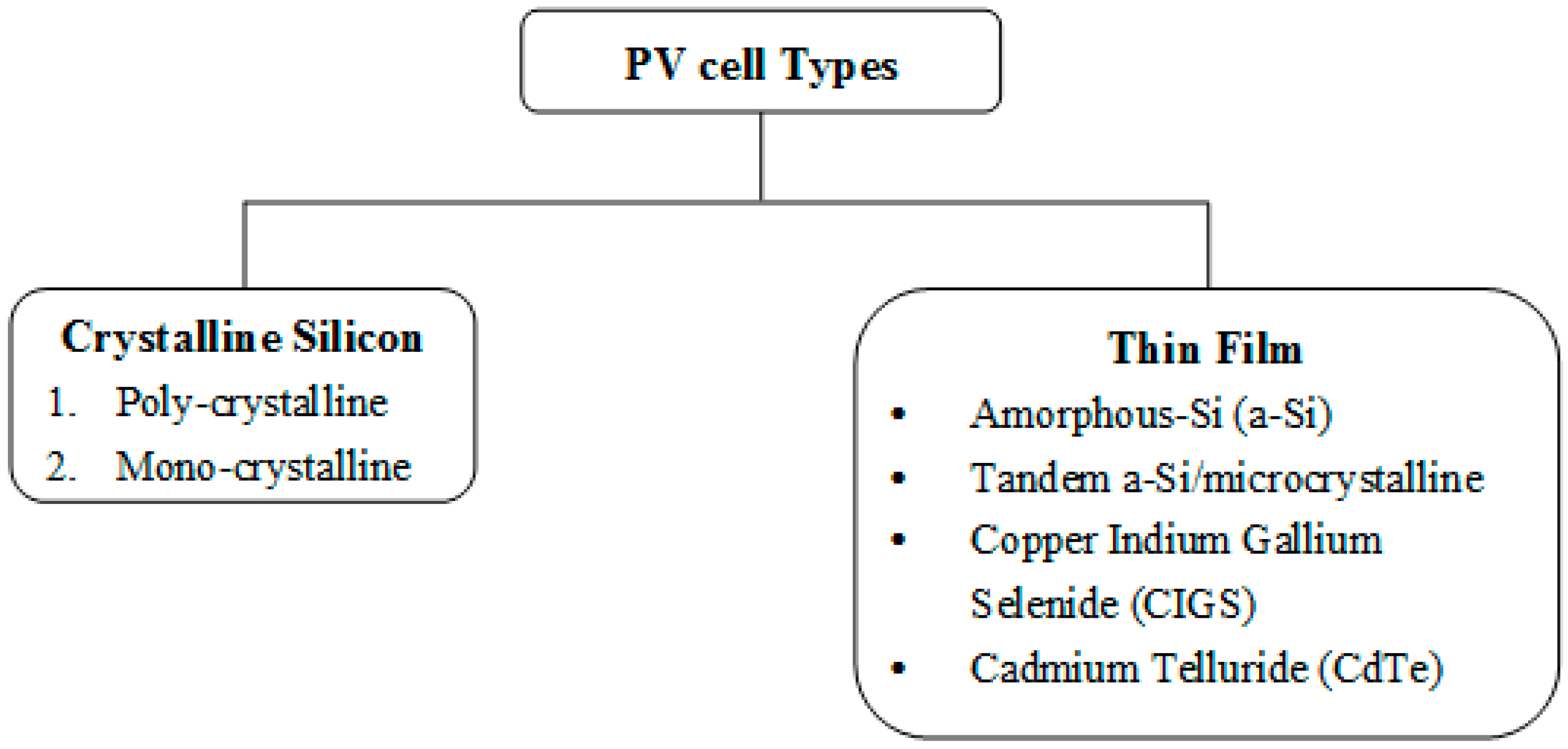
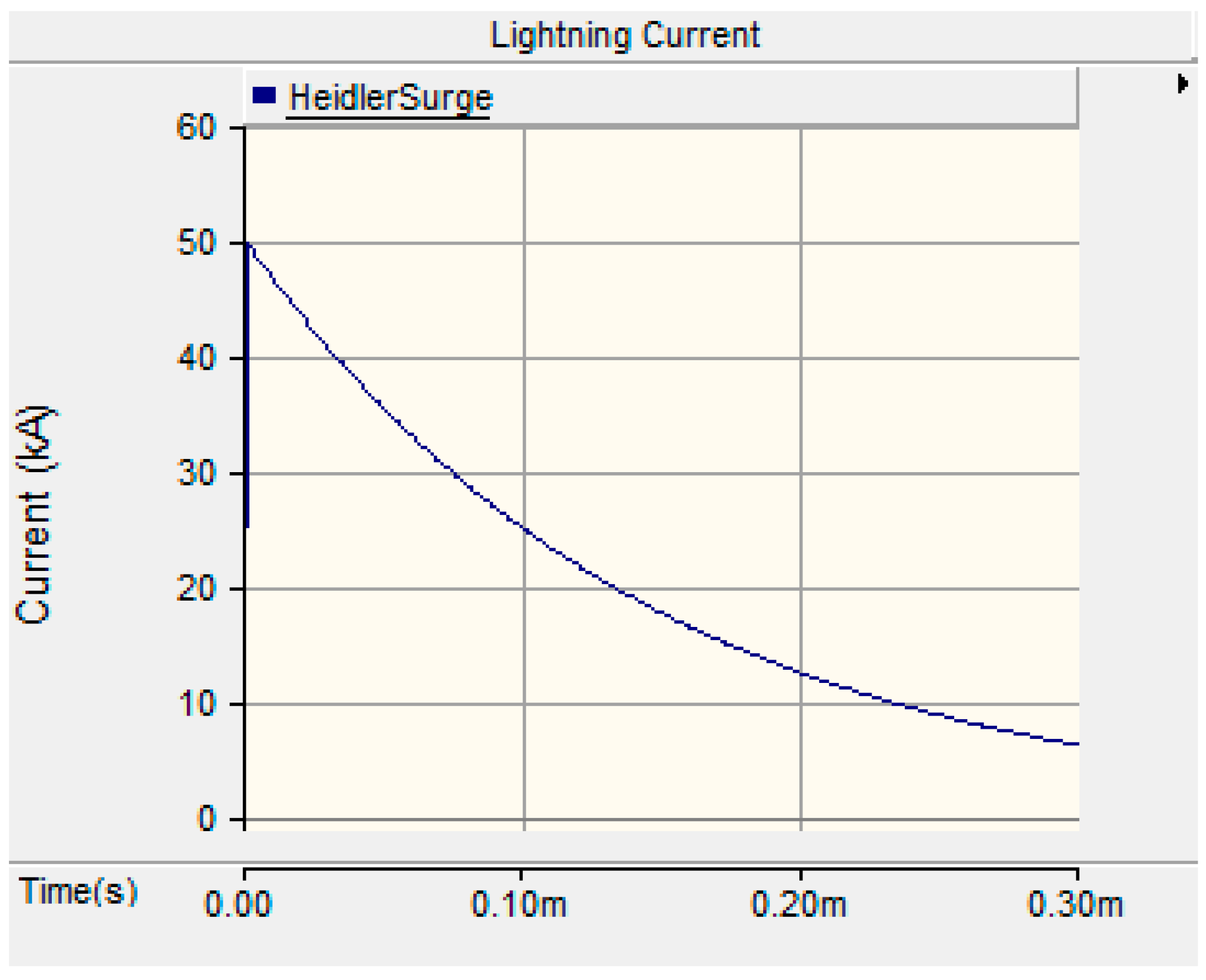
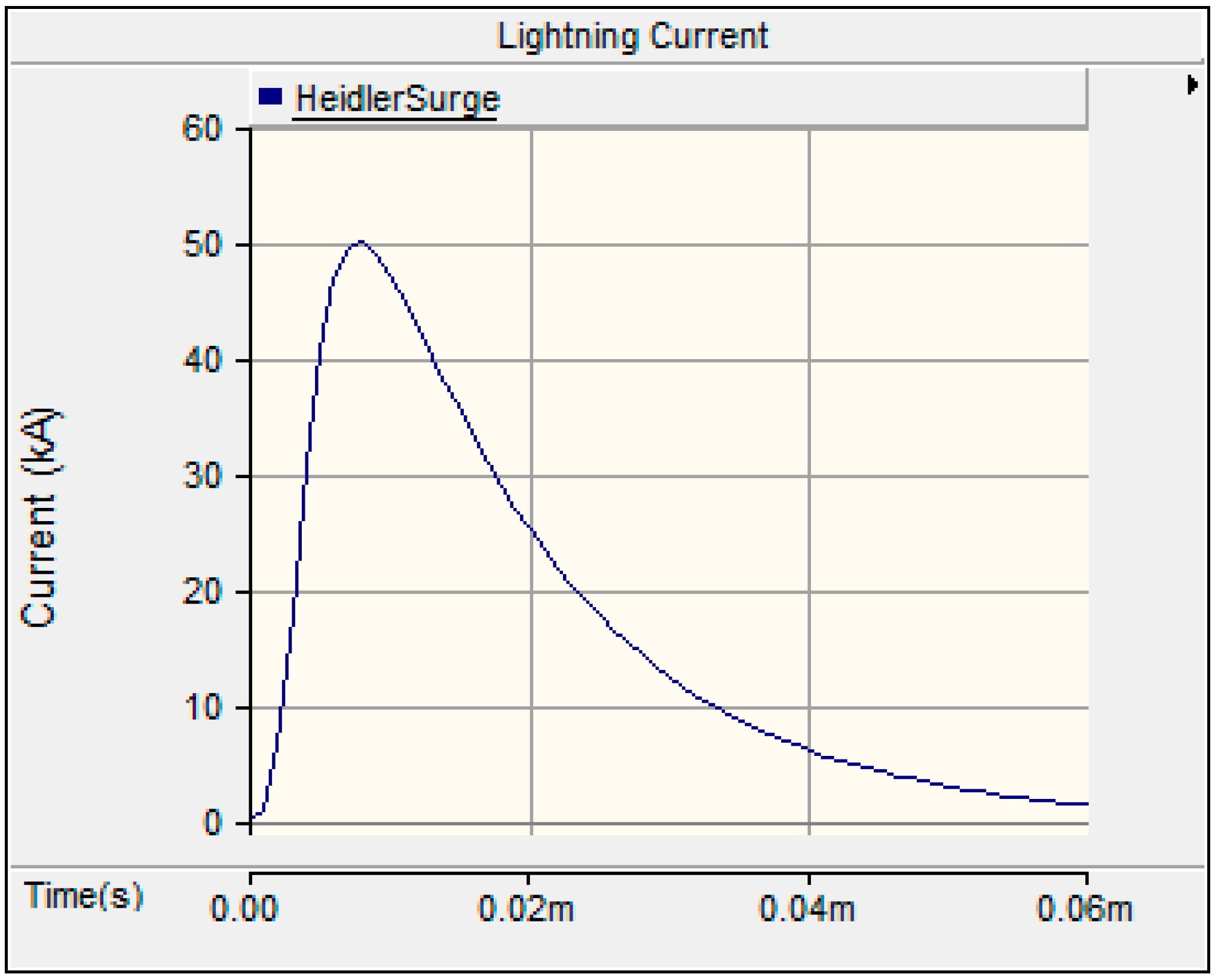
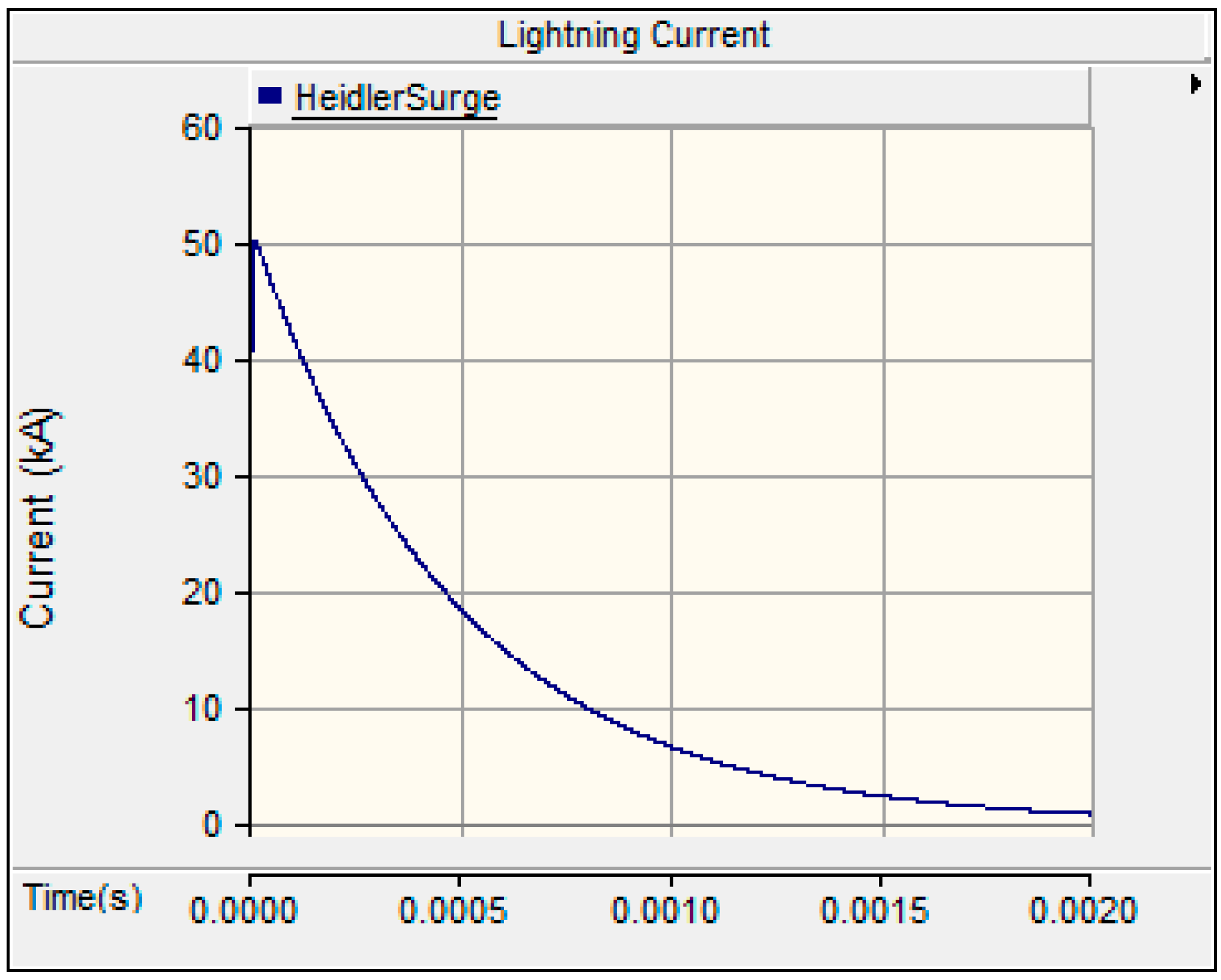
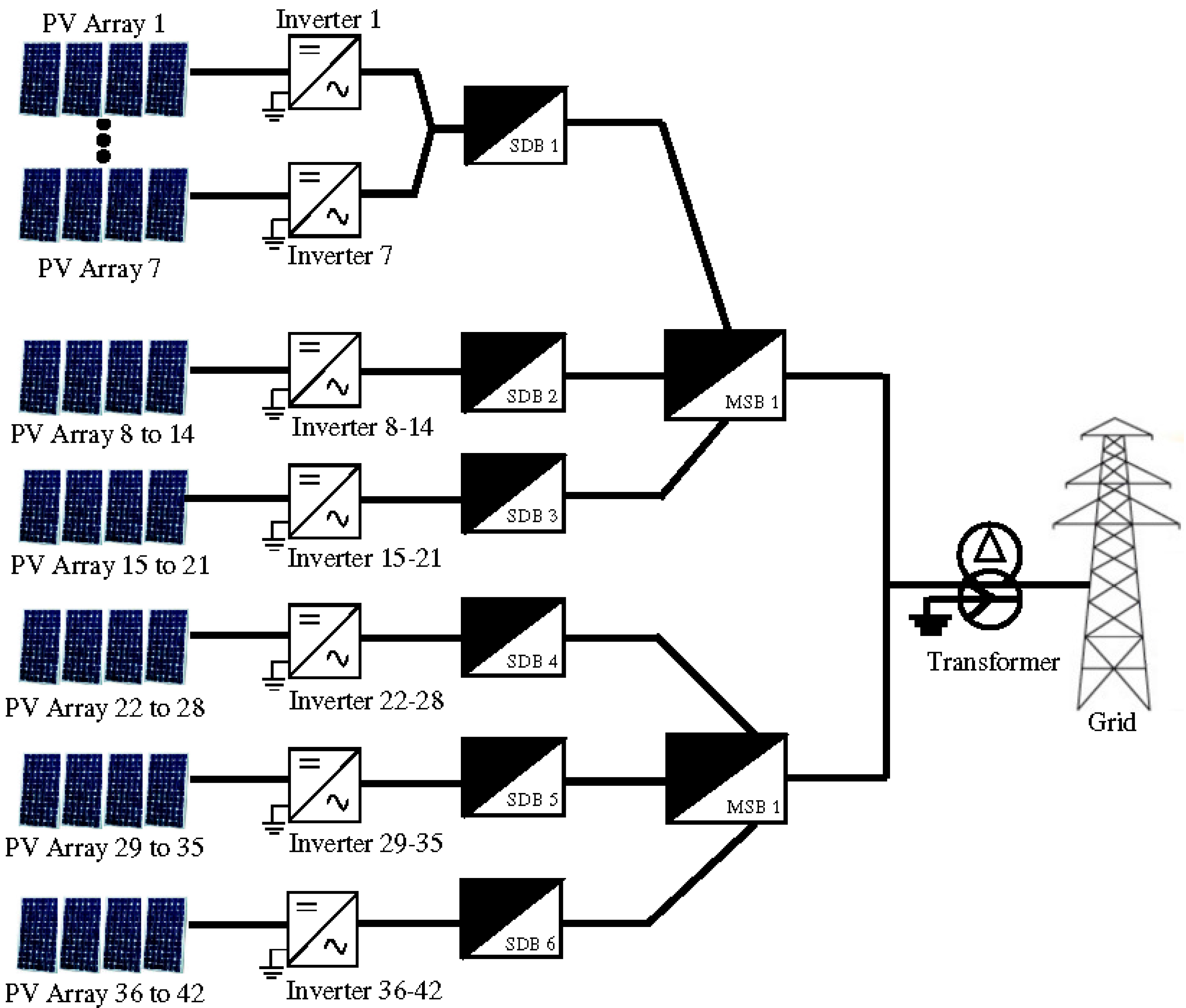

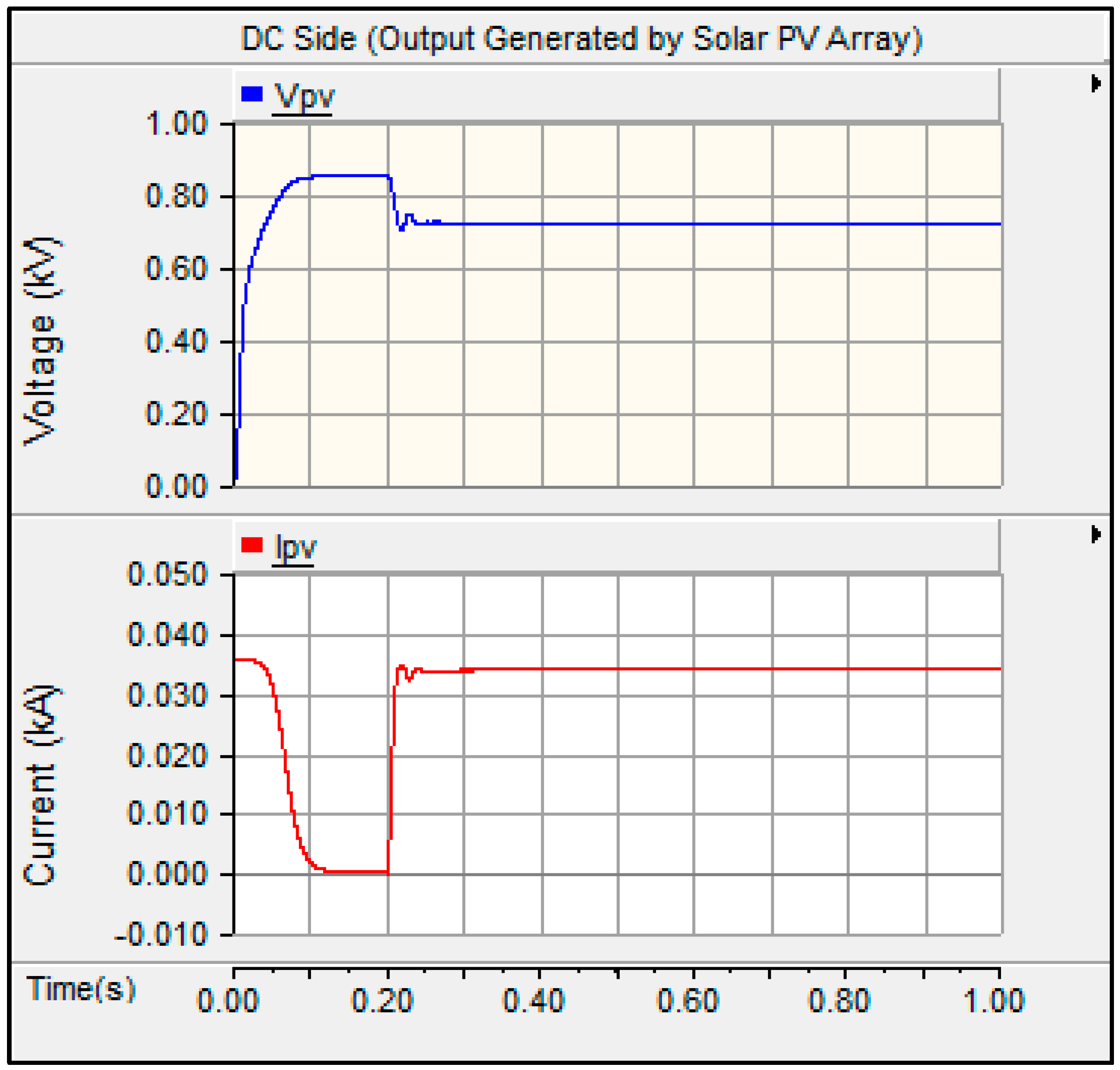
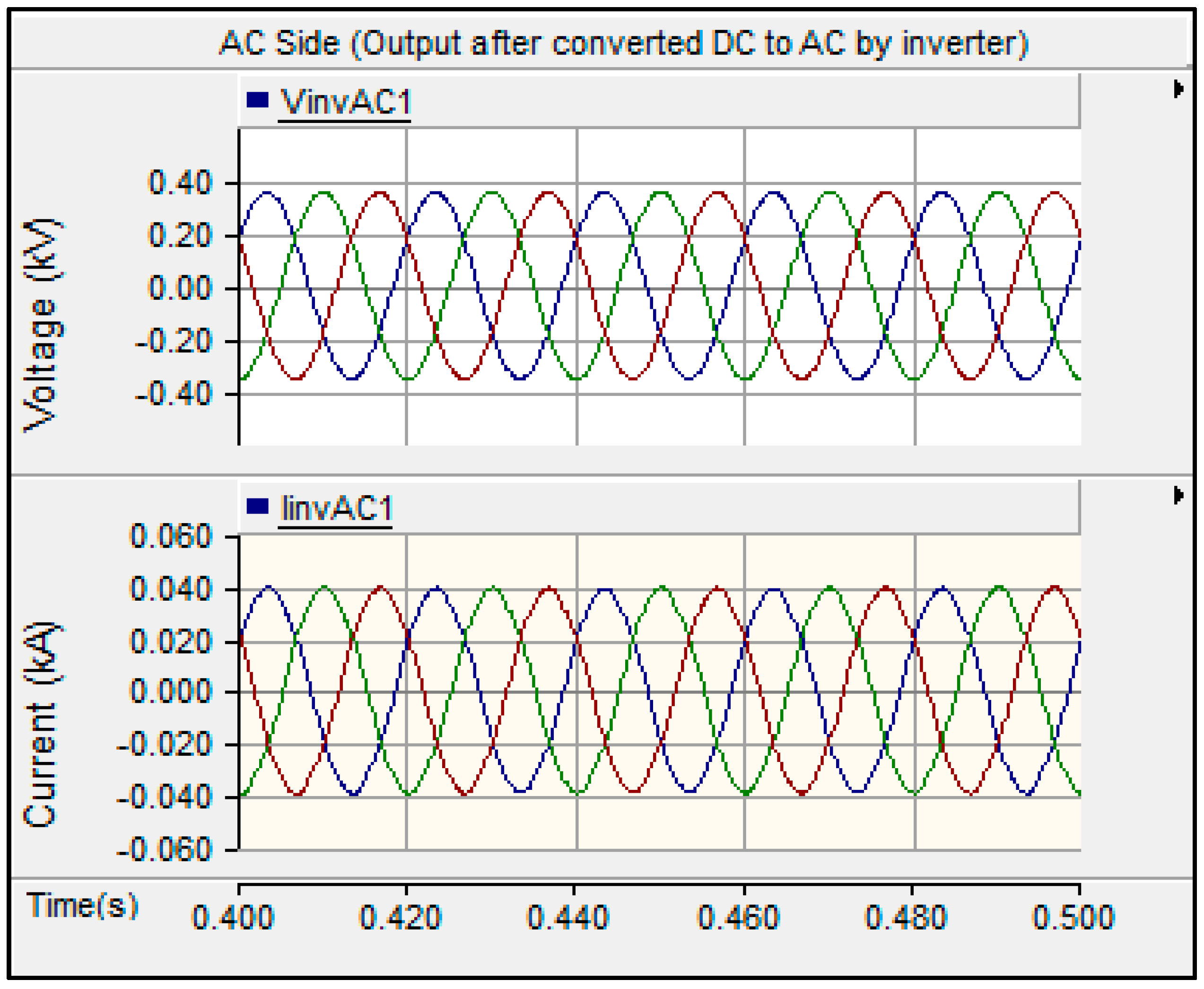
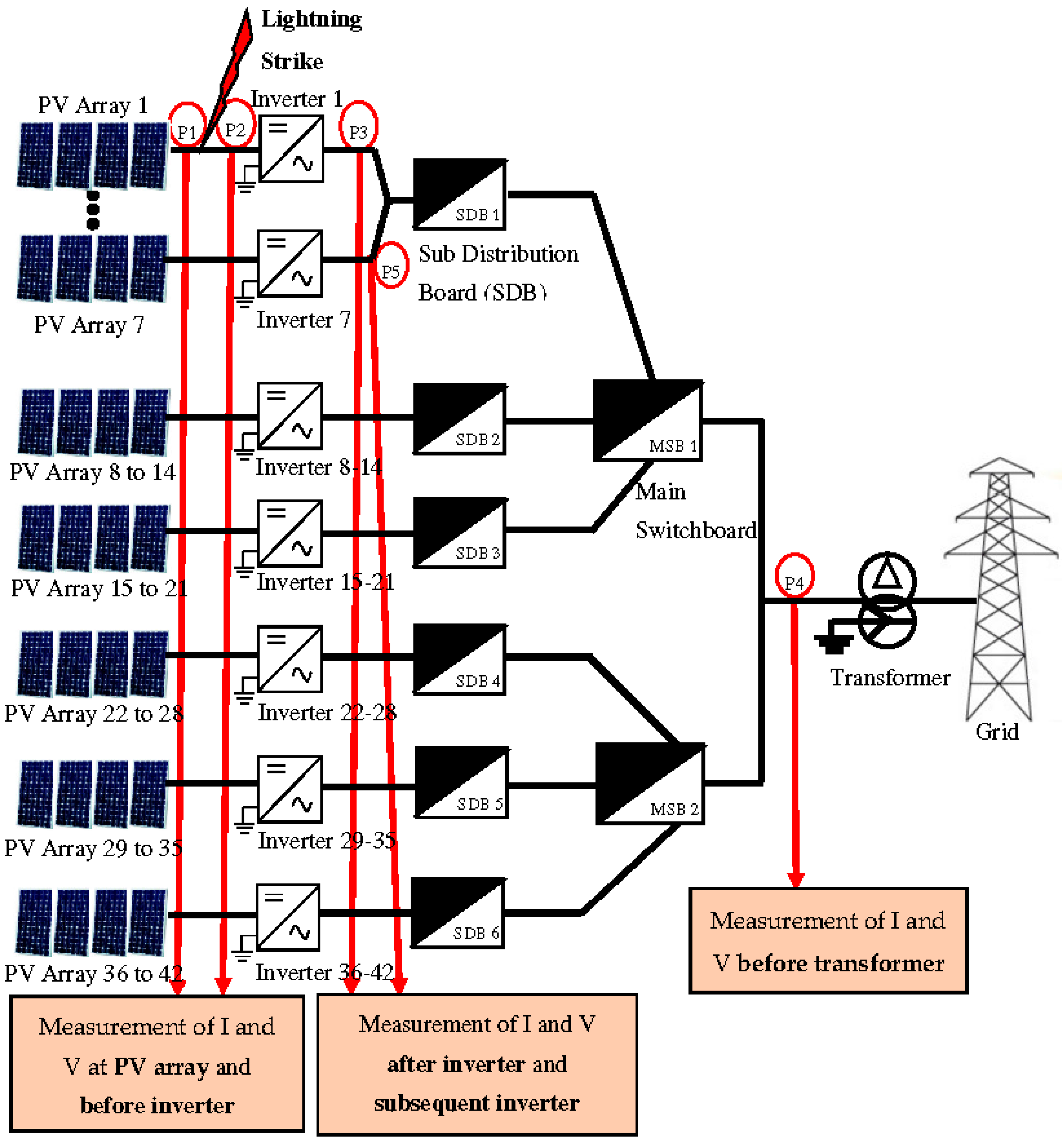


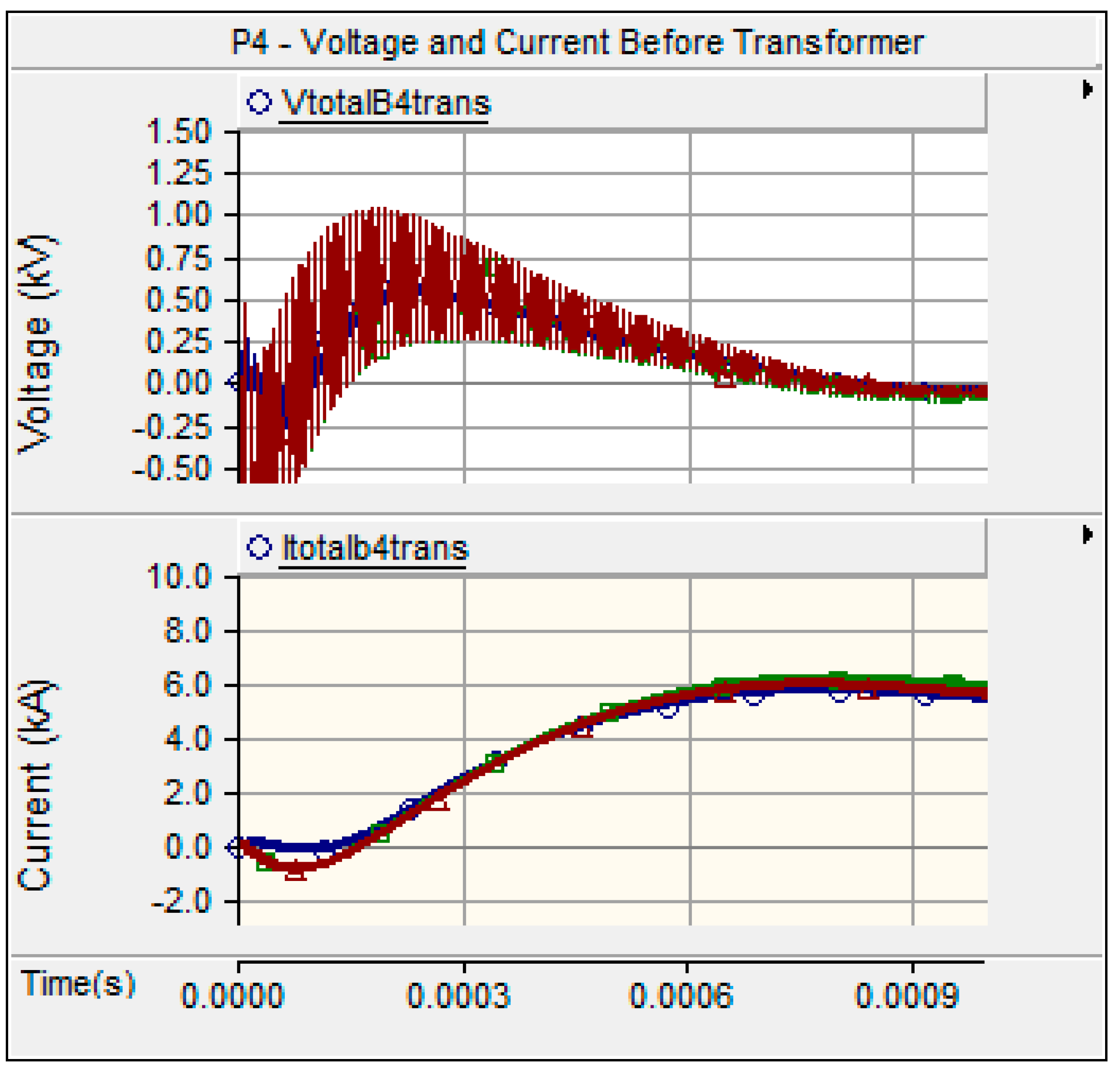
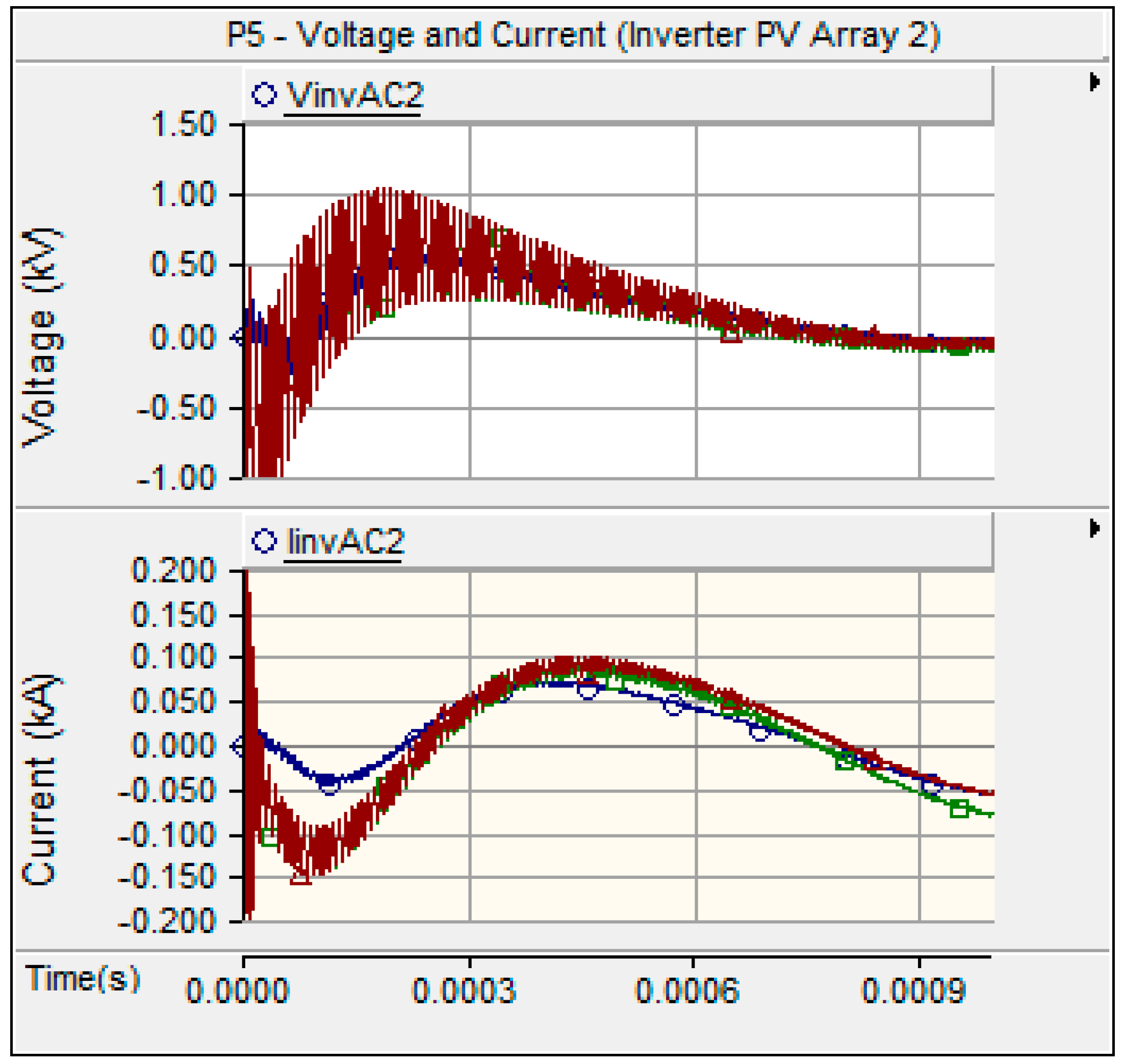
| Component | Description |
|---|---|
| Solar PV |
|
| Inverter |
|
| Switching device (circuit breaker) |
|
| Fuse |
|
| PV kWh meter |
|
| Batteries |
|
| Standards | Title |
|---|---|
| MS 1837-2010 | Installation of Grid-connected Photovoltaic (PV) System |
| MS IEC 62305 1-4:2007 | Protection against lightning Part 1: General Principles Part 2: Risk Management Part 3: Physical damage to structures and life hazard Part 4: Electrical and electronic systems within structures |
| MS IEC 60364-7-712:2007 | Electrical Installations of Building—Part 7-712: Requirements for special installations or locations—Solar Photovoltaic (PV) power supply systems |
| MS IEC 61836:2010 | Solar Photovoltaic Energy System—Terms, Definitions, and Symbols |
| MS IEC 62446:12 | Grid connected photovoltaic systems—Minimum requirements for system documentation, commissioning tests and inspection |
| MS IEC 61727:2010 | Photovoltaic (PV) systems—Characteristics of the utility interface |
| MS IEC 61730 1-2:2010 | Photovoltaic (PV) module safety qualification Part 1: Requirements for construction Part 2: Requirements for testing |
| MS IEC 60904 1-3:2013 | Photovoltaic devices Part 1: Measurement of photovoltaic current-voltage characteristics Part 2: Requirements for reference solar devices Part 3: Measurement principles for terrestrial photovoltaic (PV) solar devices with reference spectral irradiance data |
| MS IEC 61215:2006 | Crystalline silicon terrestrial photovoltaic (PV) modules—design qualification and type approval |
| MS IEC 61646:2010 | Thin-Film terrestrial photovoltaic (PV) modules—Design qualification and type approval |
| MS IEC 62109-1:2011 | Safety of power converters for use in photovoltaic power systems—Part 1: General requirements |
| IEC 60269-1:2010 | Low-voltage fuses—Part 6: Supplementary requirements for fuse-links for the protection of solar photovoltaic energy systems |
| EN 50380:2003 | Datasheet and nameplate information for photovoltaic modules |
| EN 50539 : 2011 | Low-voltage surge protective devices. Surge protective devices for specific application including D.C. Requirements and tests for SPDs in photovoltaic applications |
| EN 50521:2009-10 | Connectors for photovoltaic systems—security requirements and approval (German version EN 50521:2008) |
| EN 50530:2010 | Overall efficiency of grid connected photovoltaic inverters |
| EN 50548:2009-10 | Junction boxes for PV modules |
| Components | Quantities | Specifications |
|---|---|---|
| Solar Modules | 4032 modules | 60 multicrystalline solar cells |
| Power solar PV modules = 250 W | ||
| Voltage of solar PV modules = 29.8 V | ||
| Current of solar PV modules = 8.39 A | ||
| Inverter | 42 | Nominal AC Power per inverter = 20 kW |
| Sub Distribution Board (SDB) | 6 | Maximum output aggregated at SDB is 140 kW |
| Main Distribution Board (MSB) | 2 | Maximum output aggregated at MSB is 500 kW |
| Transformer | 1 | 1500 kVA step-up transformer, 433 V/11 kV |
| Grid | - | 11 kV |
| DC Output (PV Array) | AC Output | ||||
|---|---|---|---|---|---|
| (PV Array) | (Transformer) | ||||
| Vmax (V) | Imax (A) | Vmax (V) | Imax (kA) | Vmax (V) | Imax (kA) |
| 714.97 | 33.42 | 353.39 | 0.040 | 353.45 | 1.96 |
| Lightning Amplitude (kA) | P1 (PV Array) | P2 (before Inverter) | P3 (after Inverter) | P4 (before Transformer) | P5 (before Inverter 2) | |||||
|---|---|---|---|---|---|---|---|---|---|---|
| Vpv (MV) | Ipv (kA) | Vinv DC (MV) | Iinv DC (kA) | Vinv AC (kV) | Iinv AC (kA) | Vtrans (kV) | Itrans (kA) | Vinv2 (kV) | Iinv2 (kA) | |
| 2 | 0.009 | 0.024 | 0.002 | 2.04 | 0.13 | 0.021 | 0.007 | 0.188 | 0.007 | 0.004 |
| 5 | 0.022 | 0.401 | 0.007 | 4.81 | 0.32 | 0.035 | 0.015 | 0.203 | 0.015 | 0.003 |
| 10 | 0.044 | 1.34 | 0.013 | 8.91 | 0.64 | 0.061 | 0.030 | 0.23 | 0.030 | 0.003 |
| 20 | 0.088 | 3.31 | 0.026 | 17.02 | 1.27 | 0.114 | 0.060 | 0.29 | 0.060 | 0.005 |
| 30 | 0.131 | 5.31 | 0.040 | 25.11 | 1.91 | 0.17 | 0.089 | 0.34 | 0.089 | 0.006 |
| 40 | 0.174 | 7.32 | 0.054 | 33.20 | 2.55 | 0.22 | 0.12 | 0.39 | 0.12 | 0.008 |
| 50 | 0.219 | 9.33 | 0.067 | 41.28 | 3.18 | 0.27 | 0.15 | 0.44 | 0.15 | 0.010 |
| 100 | 0.437 | 19.42 | 0.134 | 81.68 | 6.37 | 0.54 | 0.30 | 0.67 | 0.30 | 0.019 |
| 150 | 0.656 | 29.52 | 0.202 | 122.60 | 9.55 | 0.80 | 0.46 | 0.89 | 0.45 | 0.027 |
| 200 | 0.876 | 39.63 | 0.269 | 162.42 | 12.73 | 1.05 | 0.59 | 1.10 | 0.59 | 0.036 |
| Lightning Amplitude (kA) | P1 (PV Array) | P2 (before Inverter) | P3 (after Inverter) | P4 (before Transformer) | P5 (before Inverter 2) | |||||
|---|---|---|---|---|---|---|---|---|---|---|
| Vpv (MV) | Ipv (kA) | Vinv DC (MV) | Iinv DC (kA) | Vinv AC (kV) | Iinv AC (kA) | Vtrans (kV) | Itrans (kA) | Vinv2 (kV) | Iinv2 (kA) | |
| 2 | 0.0135 | 0.024 | 0.0045 | 2.04 | 0.18 | 0.11 | 0.050 | 0.28 | 0.011 | 0.005 |
| 5 | 0.033 | 0.50 | 0.0113 | 5.04 | 0.44 | 0.24 | 0.027 | 0.47 | 0.027 | 0.007 |
| 10 | 0.066 | 1.42 | 0.023 | 9.97 | 0.89 | 0.47 | 0.055 | 0.80 | 0.055 | 0.008 |
| 20 | 0.133 | 3.35 | 0.045 | 19.42 | 1.78 | 0.94 | 0.11 | 1.48 | 0.11 | 0.010 |
| 30 | 0.197 | 5.29 | 0.068 | 28.40 | 2.67 | 1.40 | 0.17 | 2.16 | 0.17 | 0.012 |
| 40 | 0.264 | 7.58 | 0.091 | 37.32 | 3.55 | 1.87 | 0.22 | 2.83 | 0.22 | 0.016 |
| 50 | 0.329 | 9.22 | 0.113 | 46.22 | 4.44 | 2.33 | 0.28 | 3.51 | 0.28 | 0.020 |
| 100 | 0.656 | 19.08 | 0.227 | 90.69 | 8.89 | 4.67 | 0.56 | 6.84 | 0.56 | 0.039 |
| 150 | 0.984 | 28.94 | 0.340 | 135.13 | 13.32 | 7.01 | 0.84 | 10.13 | 0.84 | 0.059 |
| 200 | 1.312 | 38.81 | 0.454 | 179.55 | 17.77 | 9.35 | 1.12 | 13.42 | 1.12 | 0.078 |
| Lightning Amplitude (kA) | P1 (PV Array) | P2 (before Inverter) | P3 (after Inverter) | P4 (before Transformer) | P5 (before Inverter 2) | |||||
|---|---|---|---|---|---|---|---|---|---|---|
| Vpv (MV) | Ipv (kA) | Vinv DC (MV) | Iinv DC (kA) | Vinv AC (kV) | Iinv AC (kA) | Vtrans (kV) | Itrans (kA) | Vinv2 (kV) | Iinv2 (kA) | |
| 2 | 0.51 | 0.62 | 0.022 | 2.17 | 0.17 | 0.072 | 0.011 | 0.24 | 0.019 | 0.009 |
| 5 | 1.28 | 1.59 | 0.054 | 5.27 | 0.41 | 0.16 | 0.026 | 0.34 | 0.026 | 0.010 |
| 10 | 2.56 | 3.22 | 0.108 | 10.42 | 0.83 | 0.32 | 0.051 | 0.51 | 0.051 | 0.010 |
| 20 | 5.12 | 6.46 | 0.217 | 20.71 | 1.66 | 0.62 | 0.10 | 0.84 | 0.10 | 0.022 |
| 30 | 7.69 | 9.71 | 0.325 | 31.00 | 2.49 | 0.92 | 0.15 | 1.15 | 0.15 | 0.033 |
| 40 | 10.25 | 12.92 | 0.434 | 41.29 | 3.31 | 1.21 | 0.20 | 1.44 | 0.20 | 0.044 |
| 50 | 12.81 | 16.19 | 0.542 | 51.59 | 4.14 | 1.51 | 0.25 | 1.72 | 0.25 | 0.055 |
| 100 | 25.62 | 32.43 | 1.085 | 103.04 | 8.28 | 2.96 | 0.51 | 3.17 | 0.51 | 0.111 |
| 150 | 38.43 | 48.65 | 1.627 | 154.50 | 12.43 | 4.41 | 0.77 | 4.65 | 0.77 | 0.17 |
| 200 | 51.24 | 64.88 | 2.170 | 205.96 | 16.57 | 5.86 | 1.02 | 6.13 | 1.02 | 0.22 |
© 2017 by the authors. Licensee MDPI, Basel, Switzerland. This article is an open access article distributed under the terms and conditions of the Creative Commons Attribution (CC BY) license (http://creativecommons.org/licenses/by/4.0/).
Share and Cite
Zaini, N.H.; Ab. Kadir, M.Z.A.; Mohd Radzi, M.A.; Izadi, M.; Azis, N.; Ahmad, N.I.; Nasir, M.S.M. Lightning Surge Analysis on a Large Scale Grid-Connected Solar Photovoltaic System. Energies 2017, 10, 2149. https://doi.org/10.3390/en10122149
Zaini NH, Ab. Kadir MZA, Mohd Radzi MA, Izadi M, Azis N, Ahmad NI, Nasir MSM. Lightning Surge Analysis on a Large Scale Grid-Connected Solar Photovoltaic System. Energies. 2017; 10(12):2149. https://doi.org/10.3390/en10122149
Chicago/Turabian StyleZaini, Nur Hazirah, Mohd Zainal Abidin Ab. Kadir, Mohd Amran Mohd Radzi, Mahdi Izadi, Norhafiz Azis, Nor Izzati Ahmad, and Mohd Solehin Mohd Nasir. 2017. "Lightning Surge Analysis on a Large Scale Grid-Connected Solar Photovoltaic System" Energies 10, no. 12: 2149. https://doi.org/10.3390/en10122149





